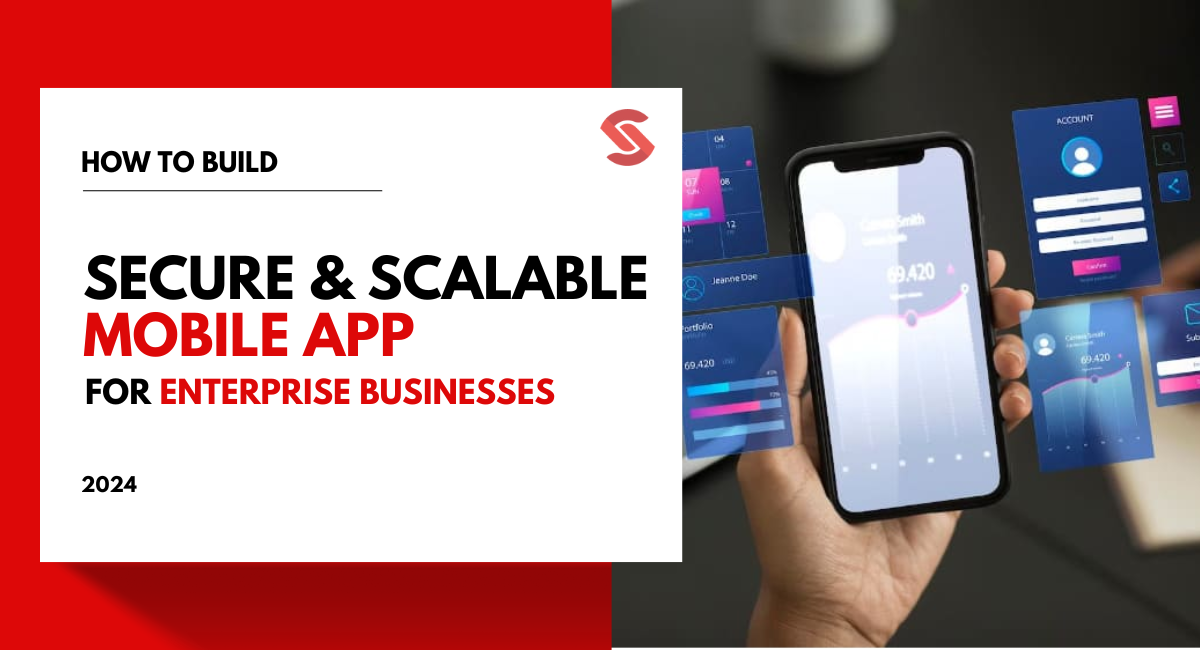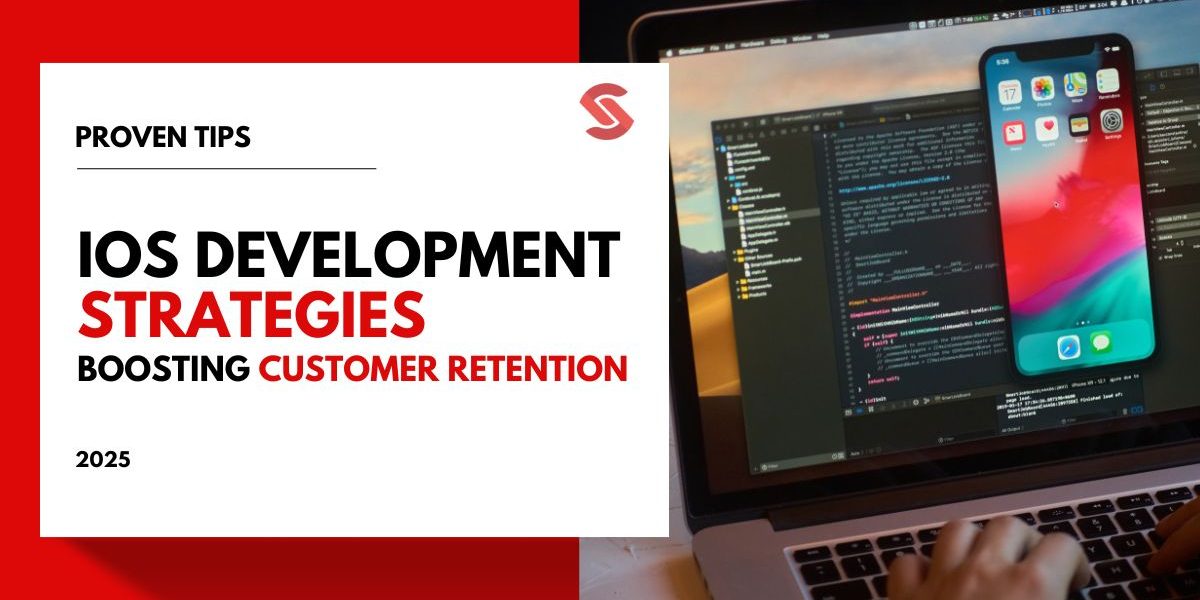Mobile apps are no longer a luxury for enterprise businesses; they’re essential. If your app can’t scale or protect sensitive data, you’re putting your growth and security at risk.
Are you facing challenges in developing an app that can handle increasing user demand and ensure data protection?
With businesses relying more on mobile solutions to engage customers, scalability and security are critical. A mobile app must grow with your business while safeguarding valuable information from cyber threats.
In this blog, we’ll explore everything you need to know about creating scalable and secure enterprise mobile applications that support your business growth and keep your data safe.
Ready to take your app to the next level? Let’s dive in!
Understanding Scalability in Mobile Apps
In terms of mobile app development, scalability refers to the app’s ability to manage more users and data without compromising performance. As businesses grow, their apps must support increasing demand. Common challenges include managing server loads and maintaining a smooth user experience.
Tools like AWS, Firebase, and cloud solutions help address these issues. Enterprise mobile apps remain efficient and responsive by focusing on scalable architecture and cloud elasticity, even with growth.
What is Scalability in the Context of Mobile Apps?
Scalability in enterprise mobile apps refers to handling growing user and data demands without slowing performance. Scalable mobile apps are vital for supporting business growth while avoiding system failures.
With scalable architecture and cloud infrastructure, enterprise apps stay fast and reliable as user numbers increase, making scalability crucial for sustained business success through mobile apps. This is where specialized application development services come into play, ensuring smooth transitions during rapid growth.
Types of Scalability in Mobile Apps

Scalability in enterprise mobile apps comes in two main types: vertical and horizontal. Each approach impacts how mobile apps handle growth and resource demands.
Vertical scalability focuses on increasing the power of a single server, while horizontal scalability adds more servers to distribute the load. Both have their place, depending on business needs and enterprise app architecture.
Here is a table that compares vertical and horizontal scalability in apps, highlighting their definitions, use cases, advantages, and limitations to help businesses choose the right approach for enterprise mobile application development.
| Aspect | Vertical Scalability | Horizontal Scalability |
|---|---|---|
| Definition | Increasing the capacity of a single server by adding more resources (e.g., CPU, RAM). | Adding more servers to distribute the load and improve performance. |
| How It Works | Upgrades the existing server’s hardware to handle higher loads. | Uses multiple servers to spread out the processing workload. |
| Best Use Cases | Suitable for smaller or less complex apps where resource needs are moderate. | Ideal for large, complex apps with many users or high data processing needs. |
| Advantages | Easier and quicker to implement; no need for multiple server management. | Provides better fault tolerance and redundancy; handles large-scale growth more effectively. |
| Limitations | Limited by the physical capacity of a single server; performance eventually hits a ceiling. | Requires more management of servers and infrastructure; may have higher initial costs. |
| Cloud Integration | Often supported by increasing cloud instance sizes (e.g., AWS EC2, Google Cloud). | Commonly used with cloud platforms that offer automatic load balancing and distributed services. |
| Examples | Useful for apps that require more processing power but don’t have massive user bases. | Ideal for apps like social networks or streaming services with millions of users. |
Key Factors Influencing App Scalability
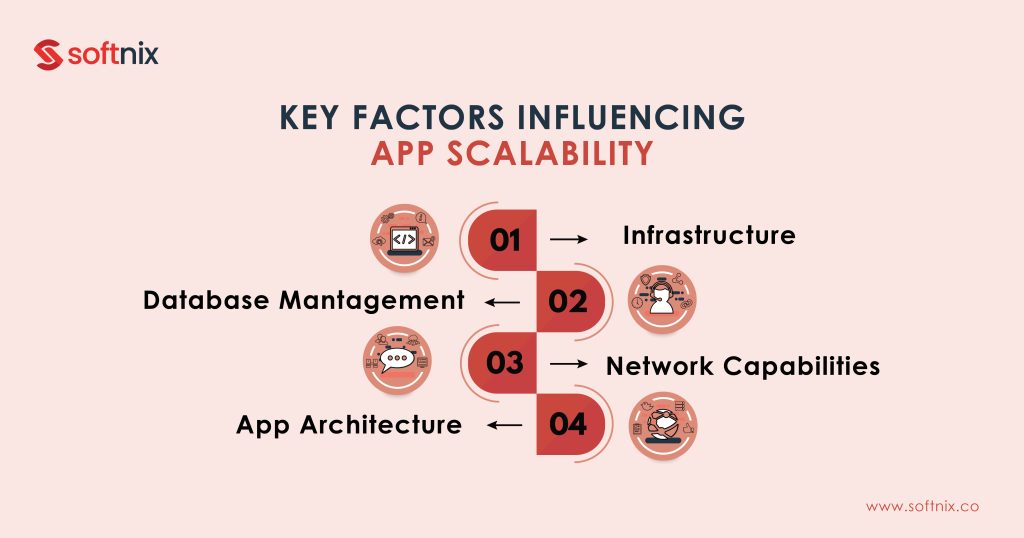
Several key factors influence how well an enterprise mobile app can scale, impacting its ability to handle increased users and data. Optimizing these factors during development is important for smooth performance as the app grows, so your mobile app can dominate the app store.
- Infrastructure: A strong cloud infrastructure supports increased user demand.
- Database Management: Efficient databases prevent bottlenecks during heavy usage.
- Network Capabilities: Network optimization ensures efficient data flow and reduces latency.
- App Architecture: Microservices architecture and load balancing distribute workloads, improving scalability.
Steps to Build Scalable and Secure Enterprise Mobile Apps
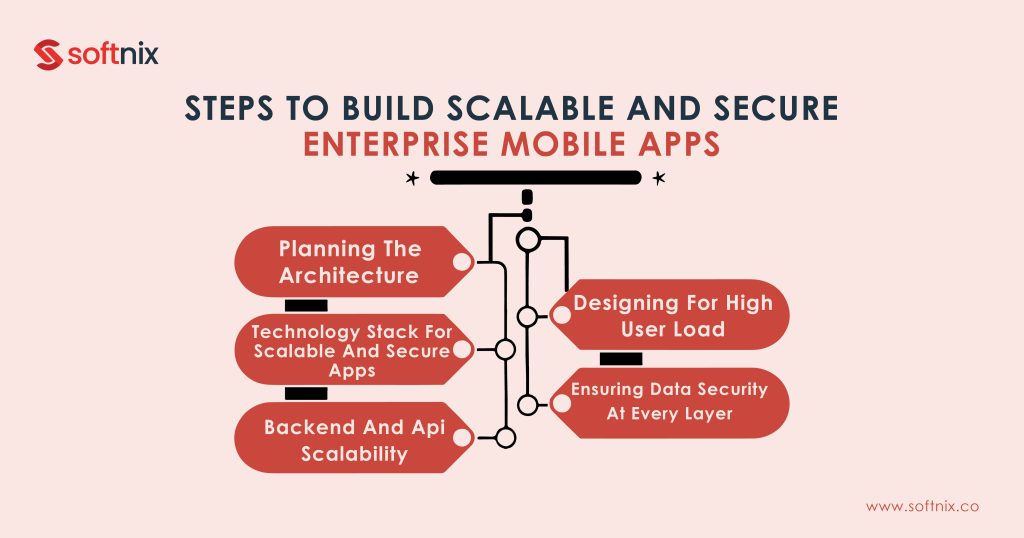
By 2023, mobile apps accounted for over 50% of global internet traffic, according to data from Ericsson, showing the critical need for scalable and secure apps in business. That’s why building scalable and secure enterprise mobile apps is important.
The development process starts by setting clear business objectives and understanding the target audience. Next key decisions during this phase is choosing the right development approach—native vs cross-platform app development. Choose a reliable tech stack, design a scalable architecture, and implement strong security measures like data encryption. Use cloud infrastructure for flexibility and load balancing on all mobile devices.
Step 01: Planning the Architecture
Choosing the right app architecture for enterprise app development is key for scalability and security. Monolithic architecture is simpler but can limit growth, while microservices offer flexibility and better scalability for complex apps.
For enterprise mobile apps, microservices allow different components to scale independently, making it a preferred choice. Cloud-based architecture further enhances the ability to manage growing user demand effectively.
Step 02: Technology Stack for Scalable and Secure Apps
For developing scalable and secure enterprise mobile apps, includes languages like Java, Swift, and Kotlin provide strong security. Frameworks like React Native and Flutter support scalability.
While databases like MongoDB and PostgreSQL handle large data efficiently. Cloud services like AWS and Firebase ensure reliable infrastructure and secure API management for smooth performance.
Step 03: Backend and API Scalability
Designing scalable backends and secure APIs is essential for handling growing user loads. In mobile application development for businesses, load balancing techniques distribute traffic evenly, while database partitioning (like sharding) improves performance.
API rate limiting ensures security by controlling data access. According to backend expert Martin Fowler, scaling APIs effectively involves secure design and efficient resource allocation to manage increased traffic without compromising performance.
Step 04: Designing for High User Load
Preparing for high user loads ensures that your enterprise app runs smoothly even under heavy traffic. Using load-testing tools helps identify performance bottlenecks and optimize scalability for millions of users. Predicting and testing for future growth is crucial to ensure the app can efficiently handle an increasing user base.
- Stress Testing: Simulates extreme traffic to measure app limits.
- Performance Benchmarks: Set clear performance goals to measure scalability success.
- Optimization Techniques: Use caching and database tuning to handle large user volumes smoothly.
- Load Testing Tools: Tools like Apache JMeter and LoadRunner assess app performance under high traffic.
Step 05: Ensuring Data Security at Every Layer
Data security at every layer is important to protect sensitive information during the development process, from the database to the cloud infrastructure of your enterprise mobile application. Each layer needs encryption, firewalls, and intrusion detection to guard against unauthorized access.
IBM’s 2022 report shows the average cost of a data breach at $4.24 million, highlighting why encryption, secure cloud storage, and application firewalls are vital to protecting enterprise apps from costly security breaches.
Tools and Technologies for Scalable and Secure App Development
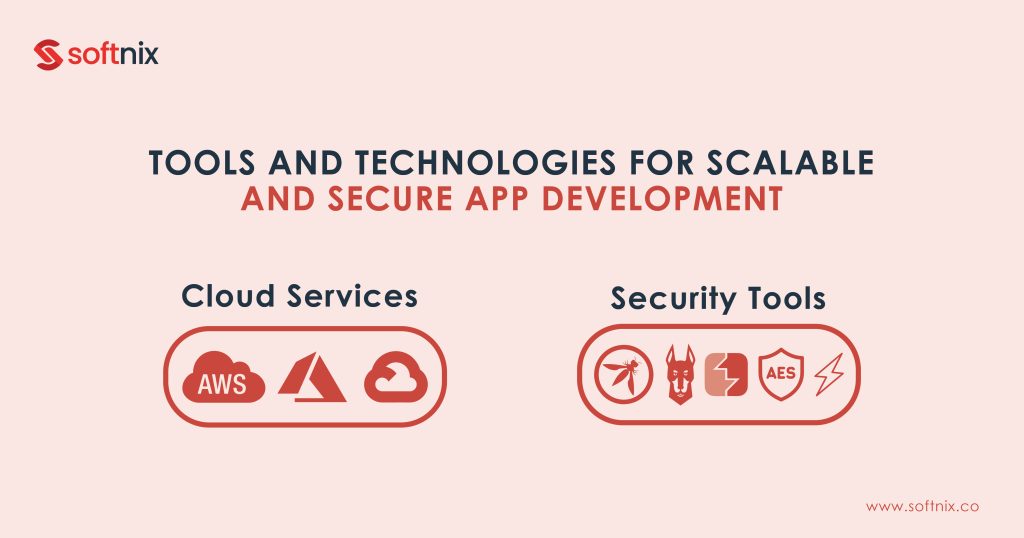
Scalable and secure mobile app development, includes using tools like AWS or Google Cloud for infrastructure management, OAuth and JWT for data security, and API gateways for service interactions.
Monitoring tools like Datadog ensure performance, while automated testing with Selenium and JMeter continuously checks scalability and security.
1. Cloud Services for Scalability
Cloud platforms like AWS, Google Cloud, and Azure offer powerful tools that allow businesses to scale their mobile apps effortlessly, adapting to user growth without infrastructure limitations.
These platforms offer auto-scaling features that adjust server resources in real-time. According to Gartner, cloud services now account for over 70% of IT spending, underscoring their critical role in enhancing app scalability and efficiency for enterprises.
2. Security Tools for Mobile App Development
Ensuring security in developing enterprise mobile applications requires using reliable tools for testing, encryption, and continuous monitoring. Developers must adopt a proactive approach to safeguard user data and prevent breaches. Developers can enhance app security with:
- OWASP: A framework for secure coding practices.
- Snyk: Identifies vulnerabilities in code and dependencies.
- Burp Suite: Penetration testing for detecting app weaknesses.
- AES Encryption: Protects sensitive data with strong encryption.
- ZAP: Scans for security issues and helps prevent attacks.
3. Best Practices in Mobile App Testing for Scalability and Security
Regular testing in enterprise mobile application development helps remain scalable and secure after launch. Load testing with tools like Apache JMeter and Locust helps identify performance bottlenecks under high traffic.
Security audits, including penetration testing, uncover vulnerabilities that could lead to breaches. Continuous monitoring and testing ensure apps perform well and stay secure as user demand grows.
Best Practices for Maintaining Scalability and Security Over Time
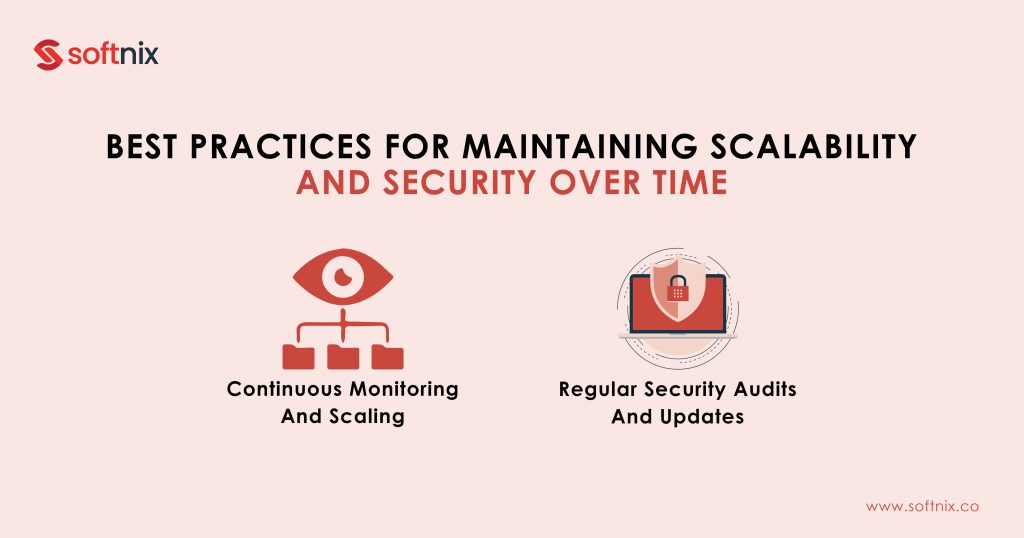
To maintain scalability and security over time, continuous monitoring is essential for tracking app performance and detecting threats. Regular security audits identify vulnerabilities, while scaling infrastructure and cloud auto-scaling adapt to growing user demand.
Refactoring code enhances performance, and frequent patch management ensures security updates are applied promptly. Together, these practices ensure long-term scalability and data protection.
1. Continuous Monitoring and Scaling
Continuous monitoring is important for ensuring enterprise mobile applications can scale smoothly while maintaining security. Tools like Datadog or New Relic track performance and detect security threats in real-time.
This allows apps to adjust resources based on demand. According to DevOps expert Gene Kim, proactive monitoring plays a key role in maintaining mobile app’s health and preventing scaling issues as user loads increase.
2. Regular Security Audits and Updates
Regular security audits help identify vulnerabilities before they become threats. Frequent audits, coupled with updates to frameworks and libraries, ensure that mobile apps remain secure against new risks.
Applying security patches promptly is key to protecting sensitive data. The OWASP Foundation recommends routine security reviews and updates to mitigate evolving vulnerabilities in mobile applications.
Conclusion
Developing scalable and secure enterprise mobile apps is key for your business growth and data protection. By focusing on strong architecture, regular monitoring, and security updates.
Enterprises can ensure long-term app success and growth. Investing in these areas helps create future-proof mobile apps that align with business goals.
FAQs about the Scalability & Secure of Mobile Application
What is scalability in mobile apps?
Scalability refers to an app’s ability to handle increasing users and data without sacrificing performance. This is achieved through scalable architecture, cloud solutions, and load balancing to ensure apps perform well, even as user demand grows.
Why is security important in enterprise mobile apps?
Security protects sensitive business data from breaches and cyber threats. Implementing strong encryption, secure APIs, and frequent security audits ensures that enterprise apps are compliant with regulations and safeguard user and company information.
How do cloud services enhance app scalability?
Cloud platforms like AWS and Google Cloud provide auto-scaling features, allowing apps to automatically adjust resources based on real-time traffic. This ensures efficient performance during peak loads without manual intervention or downtime.
What are the best tools for monitoring mobile app performance?
Tools like Datadog, New Relic, and AWS CloudWatch are widely used for continuous performance monitoring. They provide real-time insights into app health, detect security threats, and automatically adjust infrastructure to manage scaling needs.
What are microservices, and how do they aid scalability?
Microservices architecture breaks an app into smaller, independent services. This allows each service to scale independently, improving performance and flexibility. It’s ideal for enterprise apps handling large user bases and complex functions.
What are the key security measures for enterprise mobile apps?
Essential security measures include encryption (like AES), API security (using OAuth), penetration testing, and regular updates to patch vulnerabilities. These practices help prevent unauthorized access and protect sensitive business data.
How does load balancing improve app scalability?
Load balancing distributes traffic evenly across multiple servers, ensuring no single server becomes overloaded. This improves app performance, prevents crashes during high traffic, and ensures smooth user experiences even as demand increases.
Why are regular security audits necessary for mobile apps?
Regular security audits help identify vulnerabilities before they can be exploited. Audits ensure that security protocols are up-to-date, frameworks are patched, and apps meet compliance requirements, which is critical for enterprise-level applications.
What is the role of automated testing in mobile app development?
Automated testing tools like JMeter and Selenium help developers continuously test an app’s scalability and security. These tests ensure that performance remains stable during high traffic and that any vulnerabilities are addressed before deployment.
How can businesses future-proof their mobile apps?
To future-proof mobile apps, businesses should focus on scalable architecture, cloud-based infrastructure, regular security updates, and continuous performance monitoring. These practices ensure the app adapts to future user growth and evolving security threats.
What are the challenges in scaling mobile apps for enterprises?
Challenges include managing infrastructure costs, ensuring security at scale, and maintaining app performance as user numbers grow. Solutions like cloud auto-scaling, microservices architecture, and proactive monitoring help address these challenges.
How does scaling an app impact its security?
As apps scale, security risks increase due to larger user bases and more data. Implementing secure coding practices, conducting regular audits, and using tools like firewalls and encryption help maintain security as apps grow.

